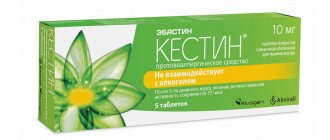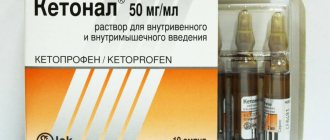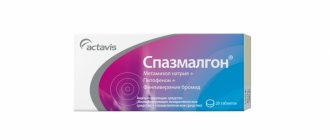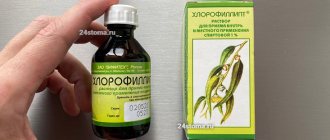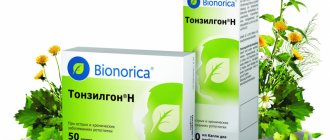The nootropic drug Cortexin was developed by domestic scientists in 1999. Initially, it was used to restore military personnel after concussion. After additional research, the effectiveness of the drug in treating various neurological pathologies was proven.
The medicine is a lyophilisate powder. It has a recognizable slightly yellowish tint, but can sometimes be white. An injection solution is prepared from the powder for further intramuscular administration. The main active component is polypeptide neuroactive complexes. The auxiliary ingredient is glycine.
You can purchase Cortexin injections for adults and children. The drugs differ in dosage. Cortexin injections, the price of which is 700 - 1300 rubles per pack, improve microcirculation in brain tissue. When used, memory improves and performance increases.
Release form
The drug is available in the form of a sterile lyophilized powder for the preparation of a solution for intramuscular administration.
The cardboard packaging is completed with two blister packs, each containing 5 bottles of lyophilisate, and instructions for use.
In pharmacies you can buy Cortexin 10 mg No. 10 and Cortexin 5 mg No. 10.
Cortexin 10 mg is available in 22 mg doses in 5 ml bottles. The product is intended for the treatment of adult patients.
Cortexin 5 mg was created specifically for use in pediatrics. It is available in 11 g bottles with a capacity of 3 ml.
Pharmacodynamics and pharmacokinetics
Cortexin is a bioregulator with a polypeptide structure, which is a complex of water-soluble neuropeptides. The molecular weight of these polypeptide fractions does not exceed 10 thousand daltons, which allows them to penetrate the physiological barrier separating the central nervous and circulatory systems.
The mechanism of action of the drug is realized through:
- activation of regulatory peptides, neurons and brain neurotrophic factors;
- normalization of the ratio of amino acids that perform mediator functions of excitatory and inhibitory types of action, as well as important brain neurotransmitters dopamine and serotonin ;
- moderately expressed GABA-ergic effects;
- reducing the level of paroxysmal (attack-like) convulsive activity of the brain and the ability to normalize indicators of its bioelectrical activity;
- preventing the formation of products of oxidative degradation of lipids (free radicals).
The nootropic effect of Cortexin is accompanied by an improvement in higher brain functions, improved memory, increased learning ability and stress resistance.
The neuroprotective effect is manifested in the ability of the drug to increase the resistance of brain tissue to the damaging effects of various endogenous neurotoxic factors and reduce the toxic effects of neurotropic substances.
The antioxidant effect is manifested in the drug’s ability to influence oxidative stress (cell damage provoked by oxidative processes) and increase the survival rates of neurons under conditions of oxygen starvation.
The mechanism of this action is associated with the suppression of free radical processes and lipid peroxidation of cell membranes, as well as with the correction of oxygen-dependent pathological conditions.
of cholesterol and triglycerides in the blood is normalized .
The tissue-specific effect of the drug is associated with an increase in the intensity of metabolism of neurons in the central nervous system and PNS, stimulation of reparative processes in the central nervous system, improvement of the functional state of the cerebral cortex and the general tone of the somatic and autonomic nervous system.
Pharmacokinetic characteristics cannot be determined, since the disintegration time of the L-series amino acids and neuropeptide fractions included in the active substance Cortexin is no more than 3 minutes.
This makes it impossible to establish the rate and extent of absorption of peptide residues, their distribution among various organs and tissues, as well as the rate and routes of their excretion from the body.
Pharmacology
After administration as an intramuscular injection, Cortexin is distributed throughout the body through the bloodstream and enters the brain structures. Due to its polypeptide structure, the drug acts on nerve cells and has a specific effect on them:
- Nootropic - improves the interaction of neurons with each other, thereby improving cognitive functions: learning, memory and attention.
- Neuroprotective - increases the resistance of nervous tissue to aggressive influences: infections, toxic substances and lack of oxygen.
- Antioxidant - reduces the intensity of lipid peroxidation processes, which results in the formation of fewer free radicals. Because of this, nerve cells can live longer.
- Metabolic - improves the supply of tissues with oxygen and nutrients.
The peculiarity of drugs from the nootropic group is that their effect does not develop immediately. The effect of the medication will be noticeable by the end of the course of therapy, and the maximum effect will be noticeable only after a few weeks.
Indications for use of Cortexin: what is the medicine prescribed for?
Indications for use of the drug are:
- infectious diseases of the nervous system caused by bacteria or viruses;
- conditions accompanied by circulatory disorders in the brain;
- TBI and its consequences;
- syndrome of diffuse brain damage of various origins;
- cerebral (suprasegmental) autonomic disorders.
In combination with other drugs, the drug is prescribed for the treatment of epilepsy , as well as for the treatment of acute and chronic inflammatory diseases of the brain and/or spinal cord of various etiologies.
For children, indications for the use of Cortexin are reduced learning ability, memory and thinking disorders, psychomotor and speech development delay syndrome in children (CPRD), various forms of cerebral palsy.
Contraindications
The drug is contraindicated in patients with hypersensitivity to cortexin and/or glycine.
Clinical studies to establish the effect of the drug on the body of a pregnant woman and the developing fetus have not been conducted. For this reason, the drug is not recommended for use at any stage of pregnancy.
Since there are no data from clinical studies regarding the use of the drug during breastfeeding, if it is necessary to prescribe Cortexin, it is recommended to stop breastfeeding.
Compatibility
An integrated approach is usually used in the treatment of neurological diseases. This means that several drugs are used at the same time.
In some cases, the combined use of medications gives a more pronounced effect, since the drugs act from different sides. Sometimes the opposite happens, when one remedy weakens the effect of another. In addition, the drugs may not affect each other's effects in any way.
Cortexin is often used together with the following drugs:
- Mexidol.
- Phezam (piracetam + cinnarizine).
- Cavinton.
- Ceraxon or Recognan.
- Pantogam.
Read more about the compatibility of Cortexin with other drugs in a separate article.
Cortexin injections, instructions for use (Method and dosage)
The drug is intended for injection into the muscle.
How to dilute Cortexin?
Before injection, the powder contained in the bottle should be diluted with one or two milliliters of a 0.5% solution of procaine ( Novocaine ), physiological solution (isotonic sodium chloride solution (0.9%)) or water for injection.
To prevent the formation of foam, they try to direct the needle towards the wall of the bottle.
How to inject a child with Cortexin?
Cortexin can be prescribed from the first days of life. In some situations, parents have to give their child injections themselves. And here questions arise about how to properly inject Cortexin and what is the best way to dilute the powder.
Before making an injection, water for injection, Novocaine or saline solution is drawn into the syringe, then the cap of the bottle is pierced and the collected liquid is poured into it.
The syringe should be removed (the needle remains in the cap) and the contents of the bottle should be thoroughly shaken until the powder is completely dissolved. After this, the syringe is reattached and the required amount of solution is drawn into it.
For an injection, it is better to take a new needle, since the needle with which the solvent for the lyophilisate was injected may already be fairly dull.
The medicine is administered slowly, as rapid administration can cause very severe pain.
For babies up to six months old, an intramuscular injection is given into the anterior surface of the thigh (so as not to accidentally damage the sciatic nerve).
For children, especially very young children, all injections are given with saline or water for injection. Injections with Novocaine are less painful than injections with saline solution, however, diluting the drug with Novocaine is allowed only if there is firm confidence that this will not cause an allergic reaction in the child (Novocaine can cause severe allergies and convulsions ).
Like other neurometabolic drugs, Cortexin is recommended to be injected before 12 noon, given its activating effect and ability to provoke psychomotor agitation.
Instructions for use of Cortexin for adults
Adult patients are given Cortexin injections once a day, daily for ten days, at a dose of 10 mg.
In case of massive ischemic stroke (MIS) in the acute phase, as well as in the early recovery period, the indicated dose is recommended to be administered to the patient twice a day (morning and evening) for ten days. After ten days, the course should be repeated.
Instructions for use of Cortexin for children
In pediatric practice, the medicine is used to treat children from the first days of their life.
For patients whose weight does not exceed 20 kg, the drug is prescribed at a dose of 0.5 mg/kg body weight. For patients weighing more than 20 kg, a dose of 10 mg is indicated.
The duration of treatment is ten days. If necessary, after three to six months the patient may be prescribed a second course.
The drug extremely rarely causes side effects, has almost no contraindications and can be used to treat even newborn babies. Its main disadvantage is considered to be its release form: Cortexin is not available in tablets, and this partly complicates its use in children, if the latter require several courses.
How to properly administer Cortexin to children
A child’s body has its own characteristics, so Cortexin treatment of patients under 18 years of age has a number of features:
- Dosage calculation: for children weighing up to 20 kg, the dose is calculated at 0.5 mg per kg of body weight. That is, if a child weighs 14 kg, then the volume of the drug he needs will be 14 * 0.5 = 7 mg of the active substance. This means that you need to draw 5 ml of Cortexin from one ampoule (the entire solution) and 2 ml from the other, guided by the graduation scale on the syringe. For children weighing more than 20 kg, the dose per dose will be equal to an adult - 10 mg
Cortexin is an effective and safe remedy. If possible, it is better to entrust the administration of the drug to specially trained medical professionals. If you administer the injections yourself, follow all instructions so that the medicine has the desired effect.
Analogues of Cortexin
Level 4 ATX code matches:
Bravinton
Acefen
Carnicetine
Pyracesin
Nooclerin
Semax
Piracetam
Olatropil
Fezam
Vinpocetine
Cerebrocurin
Cavinton Forte
Calcium hopantenate
Glutamic acid
Cephabol
Olanzapine
Cerebrolysate
Pramistar
Sidnocarb
Vinpotropil
Cortexin analogues in tablets:
- Armadin and Armadin Long
- Huato Boluses
- Borizol
- Glitsed
- Mexidol
- Mexiprim
- Glutamic acid
- Rilutek
- Cytoflavin
Analogues of Cortexin in ampoules:
- Armadin
- Mexiprim
- Neurotropin
- Nikomex
- Nucleo CMF Forte
- Cytoflavin
Cortexin or Cerebrolysiin - which is better?
Studies conducted on laboratory rats have shown that Cerebrolysin and Cortexin, when administered intraperitoneally and administered into the lateral ventricle of the brain, have a similar effect.
A comparative analysis of the central effects of the drugs led to the conclusion that, despite all their similarities, Cortexin is more active.
At the same time, it provokes a much smaller number of adverse reactions and can be used from birth (whereas Cerebrolysin is used in pediatric practice if there are justified indications).
According to some patients, Cerebrolysin are less painful compared to Cortexin injections.
Cortexin for children
The instructions for use of Cortexin for children permit the use of this drug from the first days of a child’s life.
Doctors' reviews of Cortexin for children confirm the manufacturer's statements that the drug practically does not cause adverse reactions, allergies , does not have a teratogenic or carcinogenic effect and is well tolerated by patients.
Its use in neurology, neonatology and pediatrics can improve the child’s behavior and his general condition with various types of tones, normalize memory function and speech, and relieve headaches.
Side effects
At the moment, cases of serious side effects of Cortexin have not been officially registered.
The drug is obtained from animal tissue through careful filtration, which reduces the likelihood of allergic reactions.
However, people with severe allergies may experience the following effects:
- Itching at the injection site.
- Redness of the skin.
- Rashes.
- Edema.
More detailed information about the side effects of Cortexin can be found in a separate article.
Reviews about Cortexin
Cortexin is a drug widely used in neurological practice. Reviews of Cortexin for adults, which can be found on numerous thematic forums, indicate the effectiveness of this drug for treating patients of all ages (both infants and the elderly).
Taking the drug allows you to speed up the recovery process after injuries and strokes , and in older people it stimulates brain function, increases the ability to remember and concentrate, and also prevents a decrease in intellectual abilities.
Reviews of Cortexin for children allow us to conclude that the drug is most often prescribed to children who have certain deviations in neuropsychic development. In particular, indications for the use of the drug are cerebral palsy and brain lesions that occurred in the prenatal period (close to the date of birth) or directly during childbirth.
Injections for children - and reviews of Cortexin confirm this - can achieve significant improvements: after a course of treatment with the drug, the child becomes calmer, he has an improvement in brain activity, an increased interest in learning, and improved memory and speech.
The use of the drug for infants (in particular, for newborns born ahead of schedule) allows you to notice obvious improvements in a fairly short time, which are manifested in the child’s calmer behavior or the emergence of new skills (for example, the ability to independently roll over from his back to his tummy and back).
Mothers whose children were prescribed Cortexin note that after the course of treatment the child literally “came to life before our eyes.” Many consider the advantages of the drug to be the absence of side effects and low toxicity of the drug. The disadvantages most often cited are the rather high price of the product and the pain of the injections.
As for doctors' reviews of Cortexin, they, despite the rather high rating of the drug on forums (an average of 4.1-4.3 on a 5-point scale), are quite contradictory: some doctors consider it a panacea, others - a dummy with unproven effectiveness .
Cortexin price, where to buy
The average price of Cortexin in ampoules of 5 ml of 10 mg each in Russia is 1200-1300 rubles, the average cost of ampoules of 5 mg is 700-900 rubles.
The price of Cortexin 10 mg in Ukraine is 800 UAH, the price of Cortexin injections for children varies within 500 UAH. In Dnepropetrovsk, Zaporozhye and other large cities, you can buy the drug both in a network of retail pharmacies and through online pharmacies with delivery directly to your home.
The drug is not available in tablets.
- Online pharmacies in RussiaRussia
- Online pharmacies in UkraineUkraine
- Online pharmacies in KazakhstanKazakhstan
Pharmacy Dialogue
- Cortexin (vial 10 mg No. 10) Geropharm RUB
1,358 order - Cortexin (vial 5 mg No. 10) Geropharm
900 rub. order
show more
Pharmacy24
- Cortexin 5 mg No. 10 powder TOV "Geropharm", Russian Federation
479 UAH. order
PaniPharmacy
- Cortexin bottle Cortexin lyophilized powder for the preparation of solution 5 mg No. 10 Russia, Geropharm
471 UAH. order
- Cortexin bottle Cortexin lyophilized powder for the preparation of solution for injection 10 mg No. 10 Russia, Geropharm
849 UAH. order
show more
Dosage
Since Cortexin is available in powder form, it must be diluted before use. To do this, use water for injection, saline solution or local anesthetic novocaine (procaine).
The resulting mixture is administered intramuscularly.
The dosage regimen of any drug is selected individually. In this case, the patient’s age and weight, his existing pathology and its severity are taken into account.
In most cases, Cortexin is administered 10 mg once a day in the morning. The duration of the course is 10 days. If necessary, the course can be repeated after 3-6 months.
For some diseases (for example, stroke), as well as in children, the regimen for using Cortexin is slightly different. You can learn about the dosing features of the drug from a separate article.
